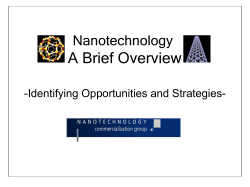
NANOTECHNOLOGY IN CLOTHING AND TEXTILES
NANOTECHNOLOGY IN CLOTHING AND TEXTILES KEY TERMS MEMS – three dimensional objects that perform a mechanical function, whose dimensions are between 1 to 100 micrometers Nanoparticle – a particle of material at the nanoscale Nanotechnology – a material or structure purposefully manufactured with dimensions between 1 and 100 nanometers to leverage the unique properties it has at that size Nanosphere – a round particle with nanoscale proportions Nanowhiskers - are ten nanometers long, made out of carbon, and designed to be flexible http://www.villagehome.org/lego/RKSA/Nanowhisker.html Nanofiber - are defined as fibers with diameters less than 1000 nm nanometers. They can be produced by interfacial polymerization and electrospinning http://en.wikipedia.org/wiki/Nanofiber Electrospinning – uses an electrical charge to spin fibers into a nonwoven pattern Polymer - is a large molecule (macromolecule) composed of repeating structural units; encompasses a large class of natural and synthetic materials with a wide variety of properties. http://en.wikipedia.org/wiki/Polymer UNIT OBJECTIVES 1. Describe the history of nanotechnology in textiles. 2. Why nanotechnology in textiles? 3. Discuss fabrication of nanofibers. 4. List properties of surface modification. 5. Describe nanoparticle composite fibers. 6. List how the military uses nanotechnology. 7. Describe Nano-Tex. 8. List new fibers in nanotechnology. 9. Name characteristics of impact resistance. 10.Give examples of athletic apparel that uses nanotechnology. 11.List characteristics of fabric protectors. 12.Describe re-cabling fashion. 13.Discuss anti-pollen fabrics. 14.Describe anti-static textiles. 15.Discuss water-repellant fabrics. 16.List characteristics of UV-protective textiles. 17.List characteristics of wrinkle resistance fabrics. 18.Describe how swimwear uses nanotechnology. 19.Discuss footwear and nanotechnology. 20. List future applications of nanotechnology in textiles. 21. List expected salaries for skilled nanotechnology workers. 22. List Oklahoma schools offering courses in nanotechnology • Nanotechnology in textiles has been around since humans began dyeing fibers and fabrics to impart color, which dates back to 2600 BC in China • Chemists have used surface chemistries not only to color textiles, but also to impart many different properties to fibers and fabrics • Today, coatings and dyes are commonplace for textiles to market products using a nanotechnology spin • The world of consumer textiles has been changed by nanotechnology. Manufacturers have created stain-resistant or moisturewicking fabrics by applying a chemical finish containing nanoparticles to cloth. • • • • • WHY NANOTECHNOLOGY? Emotional clothing Odor free clothing Stain repellant clothing Clothing that changes colors UV protection in clothing from zinc-oxide nano-particles • Clothing to prevent colds and the flu • Clothing that does not need to be washed FABRICATION OF NANOFIBERS • Fibers with diameters of several hundred nanometers or less • Nanofibers fabrication is electrospinning • Fibers are absorbent, breathable, and/or water- repellent http://www.ccmr.cornell.edu/facilities/winners07feb/dong.html SURFACE MODIFICATION • Used to impart unique properties to fibers and fabrics • Applications range from water and stain repellency, wrinkle resistance, and flame retardation http://www.bluestarsilicones.com/silicones/lang/en/bluestarsilicones /markets__applications/applications_pour_le_textile_et_le_cuir NANOPARTICLE COMPOSITE FIBERS http://www.biomedcentral.com/14726750/9/34/figure/F8?highres=y • Incorporation of nanoparticles, such as silver particles and carbon nanotubes, can be used to create fibers that are antimicrobial or have increased strength of electrical conductivity • Military uses socks that can be worn for two weeks between washing • Military has invested in fabrics reinforced with nanofibers for high performance, lightweight tents, and awnings that can better endure heavy wear and tear • \ http://www.specopstactical.com/military-clothing-c87.html • Hunting clothes use nanotechnology to cover scent http://www.p-wholesale.com/subcat/4/245/outer-wear-p22.html • Face masks have been created that when exposed to light, kills viruses and bactiera http://www.ecvv.com/product/1986093.html NANO-TEX • Nanowhiskers allows fabric to breathe without changing how the fabric feels http://www.spsj.or.jp/c5/pj/pj05/2005/pj3712.htm SMART TEXTILES 1980s – clothing that changed colors; pink when cool; blue when warm 1990s – swimmers body suit to streamline swimmers movement and reduce water on the swimmers back 2000+ - electronics embedded within clothing; the cooling jacket which prevents shivering; clothing to monitor heat rate NANO-TEX (FIBER TREATMENTS) Coolest Comfort – moisture drawn from the skin helps body temperature balance Resist Spills – liquid beads up and simply rolls off fabric or easily wipes off Repels and Releases Stains – liquids roll of and stains wash out easily Resist Static – eliminates static in synthetic fabrics TORAY INDUSTRIES http://www.birt-bespoke.com/homepage • Offers a variety of fabric treatments using a nanoscale processing technique called NanoMatrix Example: Tapguard which is soil resistant, water repellant, and oil repellant; used for uniforms in the food industry INKMAX • Developed nano-fine adhesive polymers, 70 nanometers thick, that are found on cotton fabric. This allows for ink jet printing with no water. http://yutongtex.en.made-in-china.com/customdetail/xJQxmEnAMEhQJQJEnxmyGxLE/Cotton-PoplinSpandex-Fabric.html ANTI-BACTERIAL • Silver nanoparticles and titanium dioxide are being added to fibers to provide deodorizing, anti-bacterial, and soilresistant properties http://www.flickr.com/photos/dstuart/355583438/ • Japan Exlan offers a fiber called selfclear, which relies on nanoparticles of titanium oxide http://www.asiaonline.com.au/japan/attractio ns.html • The TioTio air catalyst from Sunward Shokai provides yarn with a deodorizing, antibacterial treatment and relies on the use of titanium oxide. http://www.faqs.org/photo-dict/phrase/4648/tiltedcross-yarn.html NEW FIBERS • Greenyarn – based on nano-particles of bamboo charcoal is antimicrobial and deodorizing properties • Japan Wool Textile Nikke Miracle products -Wel Warm – moisture-absorbing and heat generating properties -Bambool – wool and bamboo fibers that are anitbacterial, deoderant, and moisture absorbent -CoolTwist – wool and yarn infused with ceramic nanopowder to block UV rays IMPACT RESISTANCE • “Liquid Armor” (shear thickening fluid) – its nanoparticle based coating material allows fabric to remain flexible, but upon impact becomes hard. Used for body armor vests, helmets, and gloves. http://personalbodyarmor.com/ http://commons.wikimedia.org/wiki/File:Bubble_Wrap.jpg • d30 has a product made of “intelligent molecules” that are incorporated in sports gear. It is a thin, flexible sheet like bubble wrap. Viscose fluid and polymer lock upon impact creating a rigid pad. ATHLETIC APPAREL • New Balance created the Skye Crop sports bra that makes use of nano channel yarn as part of its Lightning Dry Extreme Liner http://dealnay.com/945555/new-balance-wbt8307profile-crop-sports-bra.html • Yocum activewear used Coolest Comfort technology from NanoTex to wick away moisture and keep you feeling cool and dry http://www.outfitterharborsprings.com/index.php?main_page=page&id =15&chapter=0 • Eddie Bauer – Relaxed Fit and Classic Fit shirts, Performance Polos, Khakis, wrinkle-resistant shirts • Gap – Stressfee Khakis • Lee – LPK Double Pleat and Plain Front • LL Bean – Double L Chinos and Timberledge Pants • Nordstrom – Smartcare Pique Polos http://celebrifi.com/gossip/Grown-Sewn-Khaki-Pants2160623.html FABRIC PROTECTORS • Stain resistant • Fade resistant • http://www.cmienterprises.com SAFETY TIES • Can your 100% silk necktie do this? • Water just beads right up on 100% silk Safety Ties! http://www.sopranoties.com/proddetail.asp?prod=NS6618&cat=87 RE-CABLING FASHION • Implanting smell technology into multisensorial clothing • Clothing and accessories that detect and monitor pollutants or change your mood http://specialsensorystuff.blogspot.com ANTI-POLLEN • Toray Industries has a fabric that relies on nanotechnology to make them anti-pollen which means pollen grains cannot stick to them. http://s222.photobucket.com/albums/dd78/amber772011/?action= view¤t=grass.jpg ANTI-STATIC • Land’s End is one of the first companies to promote the use of the Nano-Tex Resists Static treatment in their fleece scarves, hats, and gloves. http://cgi.ebay.com/LANDS-END-Womens-FLEECE-SCARF-Skull-HAT-SET-Gray-NEW/310261293303 WATER REPELLANT • New Balance Performance Outerwear integrated the Nano-Tex Repels and Releases Stains treatment http://www.wiggle.co.uk/sugoifirewall-220-windproof-jacket/ • Circa V has a line of parkas, puffer coats, bomber jackets, and down vests that are liquid repellant. http://www.fashionmefabulous.com/2008/11/cold-weather-coats-under-150.html UV-PROTECTION • UV blocking treatment for cotton fabrics was developed using the sol-gel method. A thin layer of titanium dioxide is formed on the surface of the treated cotton fabric which provides excellent UV-protection. http://www.girlsclothingdirect.com/sun-safety-and-uvprotective-clothing/ WRINKLE RESISTANCE • Nano titanium dioxide and nano-silica are used to improve the wrinkle resistance of cotton and silk. http://www.sudsiesdrycleaning.com/wrinkle-free-3 SWIMWEAR • Sandproof by Toray Industries is a fabric that prevents sand from sticking to swimwear • Speedo LZR swimsuit uses cold plasma technology to repel water http://www.ineedprettythings.com/retroswimwear/ FOOTWEAR http://picclick.com/Amazon/Health-PersonalCare/Health-Care/Foot-Care/ • Greenyarn sells socks based on their bamboo charcoal fiber • Toasty Feet shoe liners by Polar Wrap are made of highly insulating aero gels that prevent your feet from getting cold in the winter weather ARC OUTDOORS – BROKEN ARROW • ArcticShield – this cold weather clothing is innovatively thin and unbelievably warm • X-System – Nano-silver eliminates source of body odor, making hunters nearly invisible to animals’ keen sense of smell • ARC is developing a line of hospital uniforms that will also be anit-microbial http://www.oknano.com/NanoFocus2007Pics.html FUTURE APPLICATIONS A nanocoating that could possibly have the ability to self heal Textile surfaces which can remove surface scratches and scuff marks; repel insects; and decolorize red wine spills are under development Nanotechnology is being used to develop “sensorized” garments with the ability to monitor body temperature and vital signs Self ironing suits are being developed using nanomaterials that respond to heat Bioreactive plastic coatings are being developed to protect the wearer against biological and chemical attacks Military uniforms are being developed that will change colors on command to camouflage the wearer Nanotechnology is a young and growing field An estimated two million skilled nanotechnology workers will be needed worldwide by the year 2015 – one million of them in the U.S. Graduates are receiving salary offers up to $55,000 per year with a two-year degree Graduates with a baccalaureate degree can expect salary offers up to $65,000 per year Students who choose to continue their education can expect salary offers of $100,000 OKLAHOMA SCHOOLS OFFERING COURSES Oklahoma City Community College Oklahoma State University Oklahoma University Tulsa Community College Tulsa University REFERENCES • • • • • • • • www.techexchange.com/thelibrary/nanotechnology.html www.azonano.com www.textileworld.com www.nanotechnology.com/public/features/textiles.asp www.nanowerk.com www.engineeringservicesoutsouring.com Richard Booker and Earl Boysen, Nanotechnology for Dummies, Indianapolis, Indiana, 2005. Marlene Bourne, A Consumer’s Guide to MEMS and Nanotechnology, Scottsdale, AZ, 2007. This module is one of a series designed to introduce faculty and high school students to the basic concepts of nanotechnology. Each module includes a PowerPoint presentation, discussion questions, and hands-on activities, when applicable. The series was funded in part by: The National Science Foundation Grant DUE-0702976 and the Oklahoma Nanotechnology Education Initiative Any opinions, findings and conclusions or recommendations expressed in the material are those of the author and do not necessarily reflect the views of the National Science Foundation or the Oklahoma Nanotechnology Education Initiative.
© Copyright 2025










